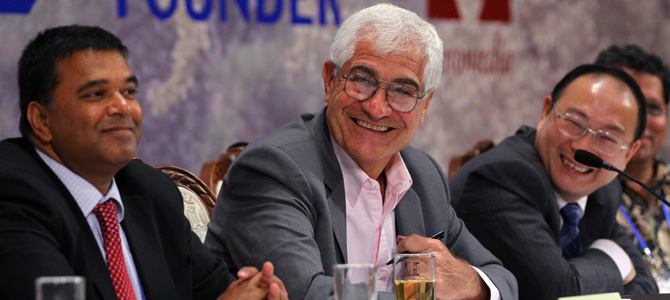
Local governments are moving to release investment plans and pave the way for economic growth that is to be driven by additional spending on infrastructure and manufacturing.
Tianjin, in northern China, released a four-year investment plan on Tuesday that calls for spending 1.5 trillion yuan ($236 billion) on 10 industries, said a report on the municipal government website.
"In the next few years, Tianjin will concentrate on the development of petrochemicals, port equipment and the aerospace industry as it tries to make them stronger global competitors," the government's report said.
Besides that, priorities are being placed on the biotechnology, "green" food and new-materials industries, according to the report.
Tianjin's release of its stimulus plan comes a day after Chongqing announced a similar policy. Chongqing, for its part, proposes to put 1.5 trillion yuan over three years into seven strategic industries, including electronics and IT, automobiles, energy and advanced equipment, Xinhua News Agency reported. As much as 300 billion yuan is to go into electronics and as much as 200 billion yuan into automobiles. Zhang Dejiang, vice-premier and Party secretary of Chongqing, said at a conference on Monday that the municipality will place a priority on the development of the industrial sector.
The plan is meant to cope with "downward pressure on the economy" and to promote the development of new types of industrialization, the municipal government said in a statement.
The city's industry is being affected by a sluggish national market as well as growing costs. Chongqing is also struggling with the task of adjusting its industrial structure and increasing its industrial production.
The development of the industrial sector has been essential to Chongqing's economy. The sector was the source of 55.4 percent of the city's GDP growth in 2011.
China saw its GDP grow at a rate of 7.6 percent in the second quarter, a three-year low.
Since June, the People's Bank of China has reduced the country's benchmark interest rates twice within a single month in order to inject liquidity into the market and encourage investment.
"However, monetary easing and fiscal stimulus didn't drive up GDP growth at the beginning of the third quarter, and disappointing economic data in July have pushed the government to take more aggressive measures in the coming months," said a report from CCB International Securities Ltd, a wholly owned subsidiary of China Construction Bank Corp.
Financial services company Barclays Capital has changed its forecast for China's GDP growth this year. In light of "weaker-than-expected" July data, it now foresees a growth rate of 7.9 percent, rather than 8.1 percent, said Huang Yiping, chief economist for Asia at the company.
CCB Securities has also lowered its forecast for the GDP growth, taking it to 7.9 percent from 8.2 percent, and predicting the growth rate will be 7.7 percent in the third quarter and 8.1 percent in the fourth quarter.
Besides Tianjin and Chongqing, Ningbo in Zhejiang province, Nanjing in Jiangsu province, Guangzhou in Guangdong province and Changsha in Hunan province have all announced stimulus plans that are aimed at encouraging investment and promoting growth.
Changsha plans to put 829 billion yuan into airport and subway lines and other projects, while Nanjing and Ningbo will take measures to increase consumption.
"We continue to expect these city-level initiatives to help the economy rebound in the second half of this year," said Zhang Zhiwei, the chief economist in China with Nomura Securities Co Ltd.
Liu Ligang, head of China economics studies at the Australia and New Zealand Banking Group Ltd, said China's economy is faced with risks that are more serious than expected, adding that further monetary policy easing and fiscal stimulus can support a rebound.
Contact writers at chenjia1@chinadaily.com.cn and xuwei@chinadaily.com.cn
Concerns over China's local stimulus plans
Is investment-based stimulus needed?
Avoid big stimulus plan
Concern increases over local stimulus
No large stimulus needed
Is fiscal stimulus necessary?
Experts warn on stimulus


 Washington to remain focused on Asia-Pacific
Washington to remain focused on Asia-Pacific RQFII target blue chips amid bear market
RQFII target blue chips amid bear market Australian recall for top two exporters
Australian recall for top two exporters China fears new car restrictions
China fears new car restrictions